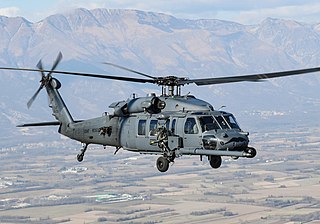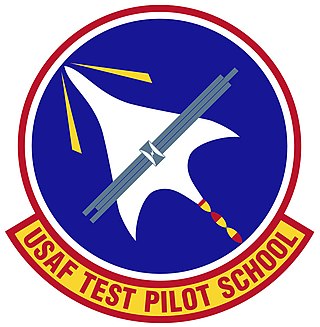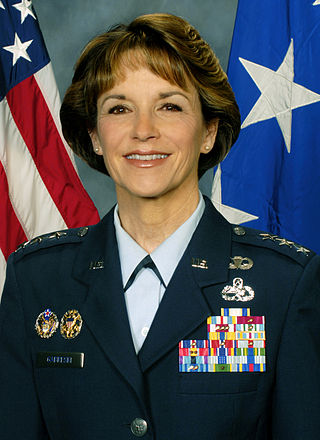
The Sikorsky MH-60/HH-60 Pave Hawk is a four-blade, twin-engine, medium-lift utility military helicopter manufactured by Sikorsky Aircraft. It is a derivative of the UH-60 Black Hawk and incorporates the US Air Force PAVE electronic systems program. The HH-60/MH-60 is a member of the Sikorsky S-70 family.

The U.S. Air Force Test Pilot School is the Air Force's advanced flight training school that trains experimental test pilots, flight test engineers, and flight test navigators to carry out tests and evaluations of new aerospace weapon systems and also other aircraft of the U.S. Air Force. This school was established on 9 September 1944 as the Flight Test Training Unit at Wright-Patterson Air Force Base (AFB) in Dayton, Ohio. To take advantage of the uncongested skies, usually superb flying weather, and the lack of developed zones in the event of crashing, the test pilot school was officially moved to its present location at Edwards Air Force Base in the Mojave Desert of Southern California on 4 February 1951.

Hanscom Air Force Base (AFB) is a United States Air Force base located predominantly within Bedford, Massachusetts, with portions extending into the adjoining towns of Lincoln, Concord and Lexington. The facility is adjacent to Hanscom Field which provides general aviation and charter service.

The Air Force Reserve Officer Training Corps (AFROTC) is one of the three primary commissioning sources for officers in the United States Air Force and United States Space Force, the other two being the United States Air Force Academy (USAFA) and Air Force Officer Training School (OTS). A subordinate command of the Air University within the Air Education and Training Command (AETC), AFROTC is aligned under the Jeanne M. Holm Center for Officer Accessions and Citizen Development at Maxwell AFB, Alabama. The Holm Center, formerly known as the Air Force Officer Accession and Training Schools (AFOATS), retains direct responsibility for both AFROTC and OTS.

Air Force Materiel Command (AFMC) is a major command (MAJCOM) of the United States Air Force (USAF). AFMC was created on July 1, 1992, through the amalgamation of the former Air Force Logistics Command (AFLC) and the former Air Force Systems Command (AFSC).

The Electronic Systems Center was a product center of Air Force Materiel Command (AFMC) headquartered at Hanscom Air Force Base, Massachusetts. Its mission was to develop and acquire command and control, communications, computer, and intelligence systems. ESC consisted of professional teams specializing in engineering, computer science, and business management. The teams supervised the design, development, testing, production, and deployment of command and control systems. Two of ESC's most well-known developments were the Boeing E-3 Sentry Airborne Warning and Control System (AWACS), developed in the 1970s, and the Joint Surveillance Target Attack Radar System, developed in the 1980s.
The Air Force Specialty Code (AFSC) is an alphanumeric code used by the United States Air Force to identify a specific job. Officer AFSCs consist of four characters and enlisted AFSCs consist of five characters. A letter prefix or suffix may be used with an AFSC when more specific identification of position requirements and individual qualifications is necessary. The AFSC is similar to the Military Occupational Specialty Codes used by the United States Army and the United States Marine Corps or enlisted ratings and USN officer designators and Naval Officer Billet Classifications (NOBCs) used by the United States Navy and enlisted ratings and USCG officer specialties used by the United States Coast Guard. The United States Space Force equivalent is known as the Space Force Specialty Code (SFSC).

Bruce Allen Carlson, was the 17th Director of the National Reconnaissance Office (NRO). He is a former four-star general in the United States Air Force and served as the sixth Commander, Air Force Materiel Command, Wright-Patterson Air Force Base, Ohio. The command conducts research, development, test and evaluation, and provides acquisition management services and logistics support necessary to keep Air Force weapon systems ready for war. After over 37 years of service, he retired from the Air Force on January 1, 2009. Carlson served as a general authority and a member of the Second Quorum of the Seventy of the Church of Jesus Christ of Latter-day Saints from April 2009 to October 2015.

The Air Force Nuclear Weapons Center (AFNWC) is a USAF Named Unit, assigned to the Air Force Materiel Command at Kirtland Air Force Base, New Mexico. The AFNWC operates at the Center level of the AFMC. It is currently under the command of Major General John P. Newberry.

Terry Lee Gabreski is a retired senior officer of the United States Air Force (USAF). She was the second woman to hold the rank of lieutenant general in the USAF. She was the Vice Commander, Air Force Materiel Command, Wright-Patterson Air Force Base, Ohio, which conducts research, development, test and evaluation, and provides acquisition management and logistics support necessary to keep Air Force weapon systems ready for war. She is the daughter of retired Air Force Brigadier General Alonzo Walter and the daughter-in-law of World War II and Korean War fighter ace Colonel Gabby Gabreski.

The 328th Armament Systems Wing is an inactive wing of the United States Air Force (USAF). It was last active in 2007, assigned to the Air Armament Center, part of Air Force Materiel Command (AFMC) at Eglin Air Force Base, Florida. It was first activated in 1942 as the 328th Fighter Group and served during World War II as a fighter aircraft training unit until disbanded in 1944 in a major reorganization of the Army Air Forces.

The 84th Combat Sustainment Group is an inactive United States Air Force (USAF) group last assigned to the 84th Combat Sustainment Wing at Hill Air Force Base, Utah, where it was inactivated in 2010. The group was formed in 1942 as the 84th Bombardment Group, one of the first dive bomber units in the United States Army Air Corps and tested the Vultee Vengeance, proving that aircraft unsuitable as a dive bomber. As an Operational Training Unit, it was the parent for several other bombardment groups, but from 1943 until it was disbanded in 1944, trained replacement aircrews as a Replacement Training Unit designated the 84th Fighter-Bomber Group.
Big Safari is a United States Air Force program begun in 1952 which provides management, direction, and control of the acquisition, modification, and logistics support for special purpose weapons systems derived from existing aircraft and systems. To that end, the program operates under procurement procedures which allow it in most cases to designate the contractor. The sole-source arrangement that allows the pairing of contractors to specific requirements is paramount to the program's success.

Janet Carol Wolfenbarger is a retired United States Air Force four-star general who served as the eighth commander of Air Force Materiel Command from June 5, 2012, to June 8, 2015. She was the first woman to achieve the rank of four-star general in the Air Force. Wolfenbarger retired from the Air Force after over 35 years of service.
The Analysis of Alternatives (AoA) in the United States is a requirement of military acquisition policy, as controlled by the Office of Management and Budget (OMB) and the United States Department of Defense (DoD). It ensures that at least three feasible alternatives are analyzed prior to making costly investment decisions. The AoA establishes and benchmarks metrics for Cost, Schedule, Performance (CSP) and Risk (CSPR) depending on military "needs" derived from the Joint Capabilities Integration Development System process. It moves away from employing a single acquisition source to the exploration of multiple alternatives so agencies have a basis for funding the best possible projects in a rational, defensible manner considering risk and uncertainty.

The 408th Armament Systems Group is an inactive United States Air Force (USAF) unit. Its last assignment was with Air Force Materiel Command's 308th Armament Systems Wing at Eglin Air Force Base, Florida. It was inactivated in 2010.

The 516th Aeronautical Systems Group is an inactive group of the United States Air Force (USAF). It was last assigned to the 516th Aeronautical Systems Wing of Air Force Materiel Command at Wright-Patterson Air Force Base, Ohio.

Badges of the United States Space Force are specific uniform paraphernalia authorized by the United States Space Force that signify ratings, special skills, career field qualifications, and serve as identification devices for personnel occupying certain assignments. Space Force occupational badges are awarded in three degrees or skill levels. Badges for space operations are awarded at basic, senior, and command levels; other occupational badges are issued in basic, senior, and master level. A star and wreath system, worn above the badge, denotes which degree or skill level a service member currently holds.

Donna D. Shipton is a United States Air Force lieutenant general who serves as the military deputy to the Assistant Secretary of the Air Force for Acquisition, Technology and Logistics. She previously served as the deputy director and commander of the Space Force Element to the National Reconnaissance Office.

John Ferdinand "JT" Thompson is a retired lieutenant general in the United States Air Force who last served as the commander of the Space and Missile Systems Center from May 2017 to July 2021. He entered the United States Air Force in 1984 as a graduate of the United States Air Force Academy.
















